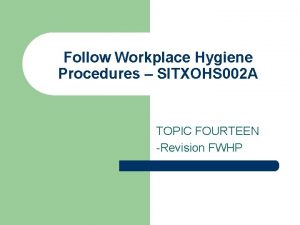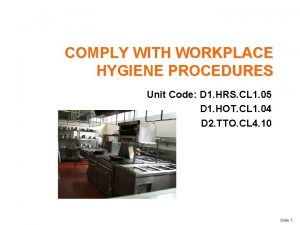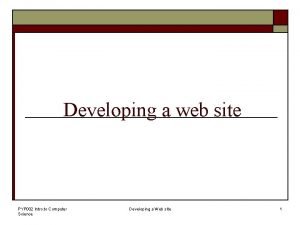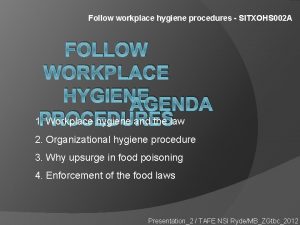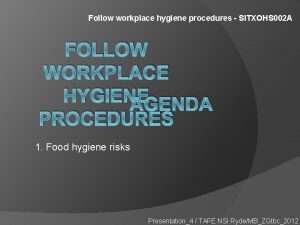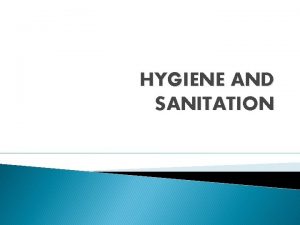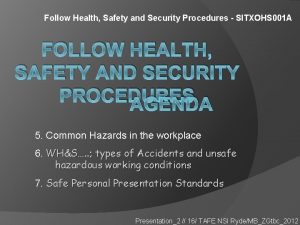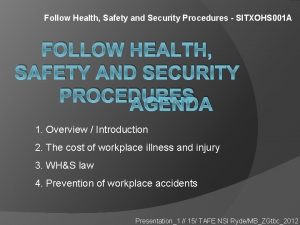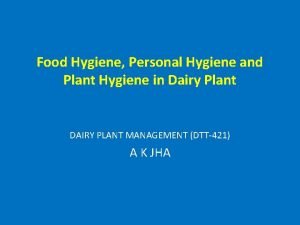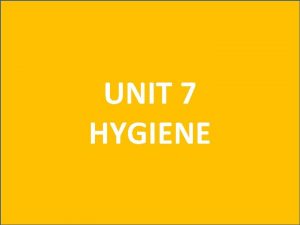Follow workplace hygiene procedures SITXOHS 002 A FOLLOW












- Slides: 12

Follow workplace hygiene procedures - SITXOHS 002 A FOLLOW WORKPLACE HYGIENE AGENDA PROCEDURES 1. Food handling Presentation_7/ TAFE NSI Ryde/MB_ZGtbc_2012

TOPIC TWELVE FOOD HANDLING 1. Legal requirements 2. Rules for Food Handling

Legal Requirements

RULES FOR FOOD HANDLING Food Handling Ø Ensure food is adequately cooked Ø Ensure potentially hazardous food is maintained at correct temperatures OR limit the time food spends in the danger zone Ø Ensure food is protected from contamination Ø Ensure eating and drinking utensils and food contact surfaces are properly cleaned and sanitized Ø Ensure food contact surfaces are adequately protected from contamination

FOOD HANDLING General guidelines: Questions: Ø Cold Storage Ø What should be done? Ø Dry Storage Ø What’s difficult to do properly? Ø Frozen storage/refrigeration Ø Packaging material Ø Shelf life Ø Thawing Ø Food Contact Surfaces Ø Why? Ø What solutions can be implemented?

FOOD HANDLING Shelf life guidelines Storage Temperature Recommended Shelf Life Dry Store 10°C - 15°C months for sugar, flour etc. Frozen foods - 18°C Fresh meats 1°C - 3°C beef 6 -12 months, seafood 13 months 3 -5 days Mince 1°C - 3°C 1 -2 days Fresh poultry 1°C - 3°C 1 -2 days Fresh fish and shellfish Small goods 0°C 2 -3 days 2°C - <4°C 3 -10 days optimum Dairy foods 0° - <4°C 5 -7 days Fresh fruit & veg 6° - 8°C 1 -2 weeks Tropical fruits e. g. bananas 12°C 3 -10 days

FOOD HANDLING Thawing: Frozen foods should be thawed: Ø under refrigeration at 4 C or lower, thawing can take 24 – 48 hours so plan ahead; Ø in a microwave on defrost cycle if the food will be used immediately or transferred to other cooking or hot holding equipment. (do not use this method for large cuts of meat etc. )

FOOD HANDLING Thawing (contd. ) Ø Frozen foods should be placed in a suitable container when thawing to avoid thaw water contaminating other foods; Ø Thaw meat, seafood and poultry thoroughly – make sure there is no evidence of ice crystals on food before cooking; Ø Never thaw at room temperature Ø Food that is thawed or partially thawed is not to be refrozen.

FOOD HANDLING Preparation of Ingredients Ø Except when washing fruits and vegetables, food handlers should not contact exposed ready-toeat food with their bare hands and should use suitable utensils such as spatulas, tongs, or single -use gloves Ø Single-use gloves are used for only one task such as working with ready-to-eat food or with raw meat, chicken, seafood etc and discarded when damaged or soiled, or when interruptions occur in the operation.

FOOD HANDLING Preparation of Ingredients Ø Hands are washed frequently using the handwashing facility in the work area. Ø During pauses in food preparation, utensils are stored: Øin the food with their handles above the top of the food and the container Øon a clean portion of the food preparation table or cooking equipment; Øin running water of sufficient velocity to flush particulates to the drain, if used with moist food; and Øin a clean, protected location if the utensils are used for a food that is not potentially hazardous.

FOOD HANDLING Preparation of Ingredients Ø Ice, ice cream or other frozen desserts are served using an approved scoop. Hands, cups, glasses or cans are not to be used. Ø Single service items are discarded after one use. Potentially hazardous food products are not kept in the temperature danger zone (5 - 60 C) any longer than 30 minutes while preparing. Ø Potentially hazardous ready-to-eat food products are kept at 4 C or below. Ø A clean spoon, not fingers, is used to taste food during preparation and the sampling spoon is not re-used unless cleaned and sanitised.

FOOD HANDLING Special Ingredient Requirements (High Risk Foods): Ø Eggs Ø Sandwiches and Salads Ø Canned Foods Ø Leftovers Ø Fruits and Vegetables Ø Condiments Ø Raw Meat, poultry and seafood Ø Prepared Ingredients
